Coronavirus Today: What a year it’s been
- Share via
Good evening. I’m Thuc Nhi Nguyen, and it’s Friday, March 5. Here’s the latest on what’s happening with the coronavirus, plus ways to spend your weekend and a look at some of the week’s best stories.
This newsletter turns 1 year old today. Welcome to our birthday party!
We’ve passed this newsletter through several writers as we’ve progressed through different stages of the pandemic. Along the way, we‘ve tracked the ebbs and flows of life as coronavirus conditions and government guidelines changed.
At first, masks were recommended only for medical workers and those showing symptoms. Soon everyone needed one. Now we’re supposed to wear two.
There‘s been a lot of frustration over the past 12 months, but a new study confirms that our sacrifices were worth it — including the old T-shirt that became your first mask.
Researchers at the Centers for Disease Control and Prevention tracked the changes in COVID-19 case and death rates in counties across the United States over the past year and found that public health recommendations like wearing masks and avoiding shared spaces do indeed work, my colleague Amina Khan reports.
Last April, 39 states and Washington, D.C., began issuing mask mandates, according to the report. And in March and April 2020, 49 states along with Washington prohibited all on-premises dining at restaurants, though by mid-June, those restrictions had been lifted.
Researchers studied the case rates before and after the policy changes and found clear evidence that growth rates for new COVID-19 cases and deaths fell when mask mandates were put in place. They also reported that both growth rates rose after restaurants were allowed to reopen, whether for indoor or outdoor dining.
The findings come at an interesting time, as some states are lifting their mask mandates and opening businesses at full capacity. California is not one of those — the state advised residents to wear two masks this week — but there are still growing opportunities for sectors of the economy.
Starting April 1, amusement parks will be eligible to reopen at 15% capacity in counties that are in the red tier, the second strictest in California’s four-step reopening roadmap. Fans can also return to outdoor sporting events and live performances on that date — even in counties in the purple tier, as long as there are no more than 100 people in attendance and no concession or concourse sales.
Previously, large amusement parks were not allowed to open until a county reached the yellow tier, the least restrictive level. Three counties in Southern California with large theme parks — Los Angeles, Orange and San Diego — are still in the purple tier, but could soon move into the red tier after the state announced sweeping changes to its vaccine program that tie inoculations to the reopening strategy.
Once 2 million doses of vaccine are administered in the state’s most disadvantaged communities, the state will relax the threshold to enter the red tier from 7.0 new cases per day per 100,000 people to 10 per day per 100,000 people. L.A. and Orange counties are already in that range, meaning they could move into the red tier within a few weeks.
With the economy opening up and spring break on the horizon, L.A. County is urging residents to double down on precautions and suspend any travel plans.
“Spring travel can lead to another surge that, frankly, would be almost impossible to tolerate,” L.A. County Public Health Director Barbara Ferrer said Thursday. “Travel increases the risk of getting and spreading COVID-19.”
Despite the steady decline in cases since the surge’s peak in January, the county’s travel advisory is still in effect. Residents are urged to stay within 120 miles of their homes and avoid travel unless it’s necessary for work, study or medical care. Anyone who arrives from out of state must self-quarantine for 10 days.
And after a year of plenty of grim milestones, here is a great milestone: California has just surpassed 10 million vaccine doses administered. And here’s more good news: New data suggest that more people are willing to sign up for a vaccine, which would help put an end to the pandemic.
Motivated in part by the emergence of new coronavirus strains, 69% of U.S. adults surveyed by the Pew Research Center in February now say they’ve had at least one dose of COVID-19 vaccine or intend to become vaccinated. That’s up from 60% in November and 52% in September.
Epidemiologists estimate that up to 85% of the country will need to be vaccinated in order to achieve herd immunity. At that point, the coronavirus will have difficulty finding new hosts to infect, and the outbreak will come to an end.
And how’s this for a birthday present: A last-minute deal among Senate Democrats Friday evening clears the way for a new COVID-19 relief bill to become law before the unemployment benefits of 10 million Americans expire on March 14.
To appease moderate Sen. Joe Manchin (D-W.Va.), legislators agreed to cut the weekly federal unemployment supplement in their bill from $400 to $300. But in a nod to progressives, the weekly benefit will last until Sept. 6, slightly longer than under the House version. A final Senate vote is expected over the weekend.
By the numbers
California cases and deaths as of 5:50 p.m. on Friday:

Track California’s coronavirus spread and vaccination efforts — including the latest numbers and how they break down — with our graphics.
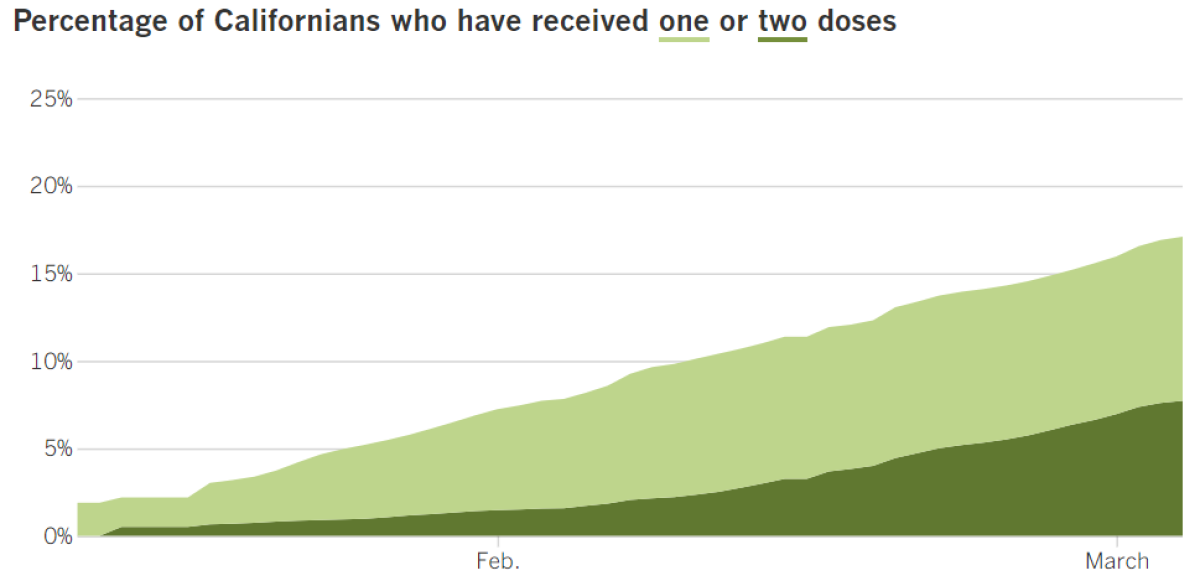
See the current status of California’s reopening, county by county, with our tracker.
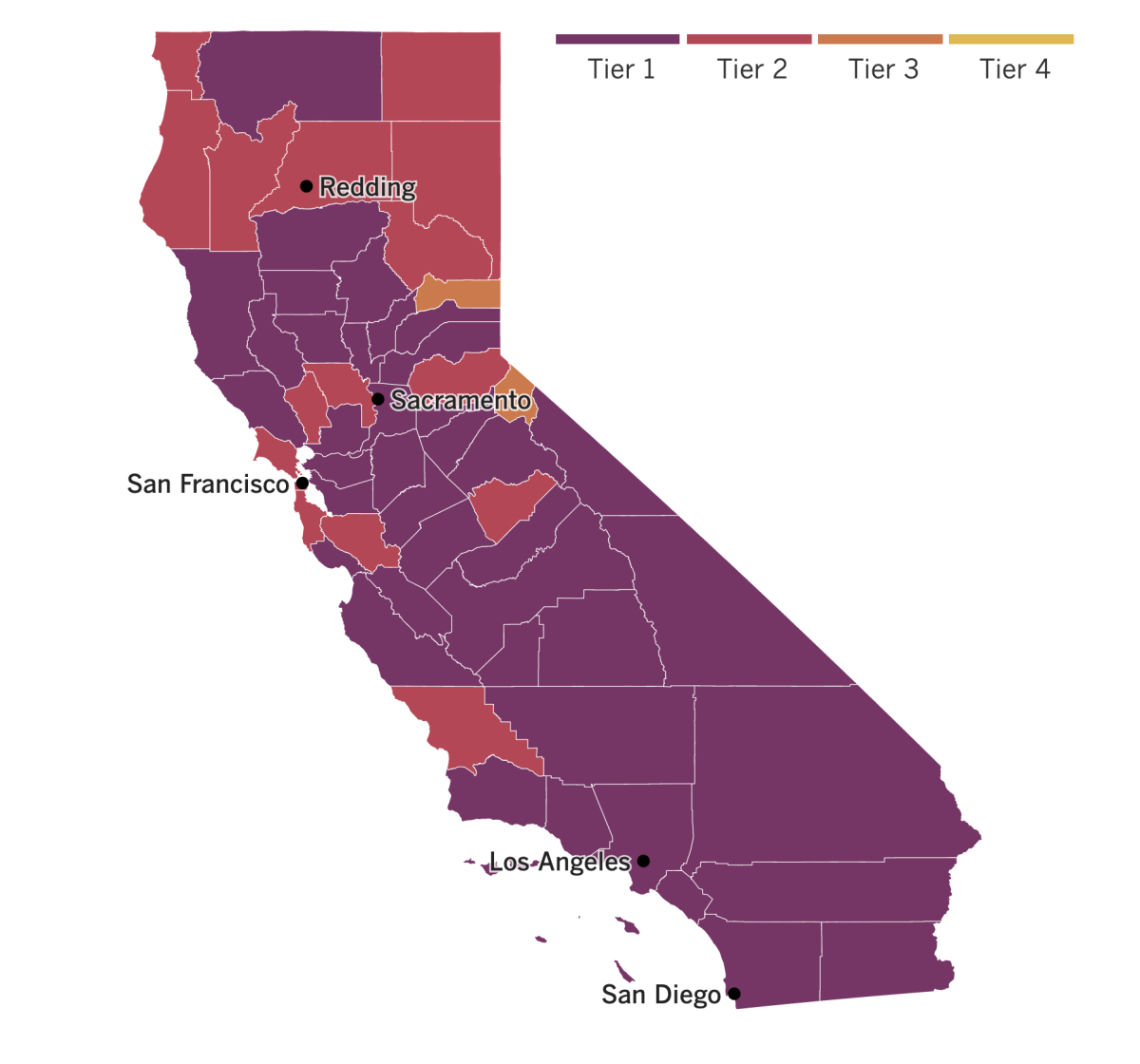

What to read this weekend
Love in the time of COVID
Two matching armchairs sit in Gordon Norman’s Glendora living room. The set has been missing a key component for almost a year.
Last April, Gordon’s wife Diane moved to an assisted living home in Covina because she has Alzheimer’s disease. Because of the COVID-19 pandemic, Gordon hasn’t seen her in nearly a year, but he holds on to hope that they’ll be able to reunite soon, my colleague Brittny Mejia reports.
Gordon and Diane have been married for 54 years. He was a band director at Glendale High School when they met. Years later, they opened a travel agency together, specializing in serving bands and musical groups. In June 2017, she was diagnosed with Alzheimer’s after he started noticing how she would misplace her purse or get quiet around people she knew.
“When you marry, you never know what’s down the road,” Gordon said. “You take it, good or bad.”
Gordon tries to FaceTime with her at least every day, calling from one of the brown leather armchairs while the other sits empty. The closest he‘s able to get to her is the front step of her residential home, where he drops off medicine, diapers, Pop-Tarts and cards addressed to his “Princess Di.” He then drives 50 feet up the street and calls the home to alert the employees of the new delivery.
While some grandparents have settled for seeing their grandchildren through glass during the pandemic, Gordon fears that being so close but separated by a window would only confuse her.
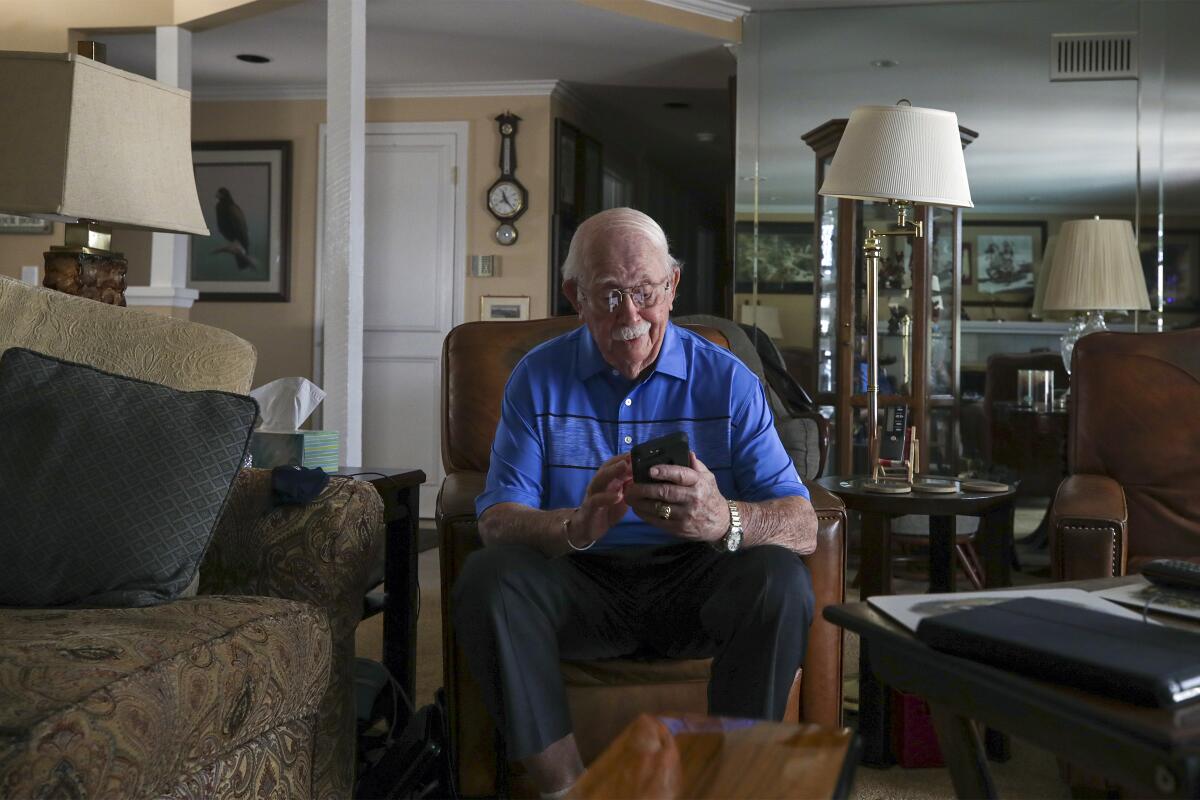
Nursing homes cash in
For decades, Kei-Ai Los Angeles Healthcare was a nursing home that allowed elderly Japanese-Americans to grow old in comfort around friends who celebrated the same holidays and ate familiar food. Problems cropped up after the financially troubled nursing home was sold in 2016. Now the pandemic has turned the home’s troubles into tragedies.
Kei-Ai has reported 97 COVID-19 deaths since the pandemic started, more than any other nursing home in the state. More than 30 residents died in December alone after the facility became one of 27 L.A. County nursing homes that voluntarily received COVID-19 patients, columnist Frank Shyong writes.
Nearly a third of the country’s COVID-19 deaths have occurred in nursing homes, making the people who live in them some of the most vulnerable of the pandemic. In retrospect, the idea of bringing COVID-19 patients into those facilities was doomed from the start. But when hospital beds were in short supply during the holiday surge, the county allowed some nursing facilities to be used as backup as long as they followed strict protocols intended to keep current residents healthy.
Under a Medicare rule change last year, skilled nursing facilities could double or even triple the amount of daily revenue they would get by taking COVID patients. All of the ones that volunteered for the program were run by for-profit companies. Facilities were required to notify staff and patients that they were accepting patients who were known to be sick with COVID-19 — but patients and doctors at Kei-An say they were never informed about the program.
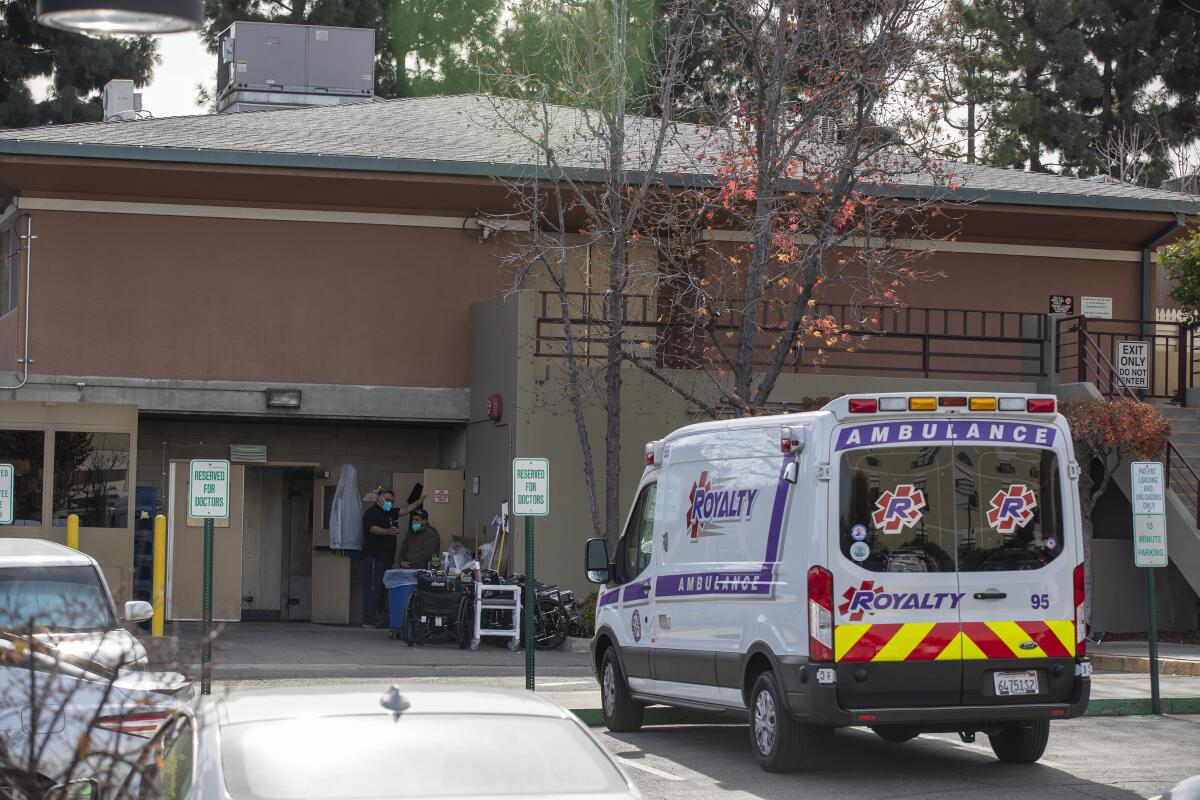
Not business as usual on Melrose
Before all this — the masks, the Plexiglas barriers and the little dots on the ground telling you where to stand in line — 1,300 people a week used to pass through Henry Alcantar’s Melrose branch of Paul Smith, a high-end men’s fashion retailer. Now the number of customers has dwindled to 200, the store manager said.
For most retailers on Melrose Avenue, business is still slow a year into the pandemic, my colleague Lila Seidman reports. Boutique owners are living on savings while keeping their fingers crossed for government assistance. Alcantar’s shop is down to two sales associates. Tattoo artists, who were shut out of work for most of the year when their shops were closed, average about a client a day.
Even one of the area’s most famous institutions is not exempt from the struggles. Pink’s Hot Dogs, the 81-year-old stand that reopened Monday after a two-month voluntary closure, has lost about 30% of its revenue, and it hasn’t seen a profit since the pandemic began.
But with case numbers dwindling, the highlighter-pink stand welcomed back all of its 25 employees. In a sign of the times, they’re taking on different coronavirus-specific roles, like making sure customers are adhering to proper social distancing rules.
For longtime fans, “it’s like coming home,” said Autumn Streat, who used to stop by when visiting the nearby Tower Records.
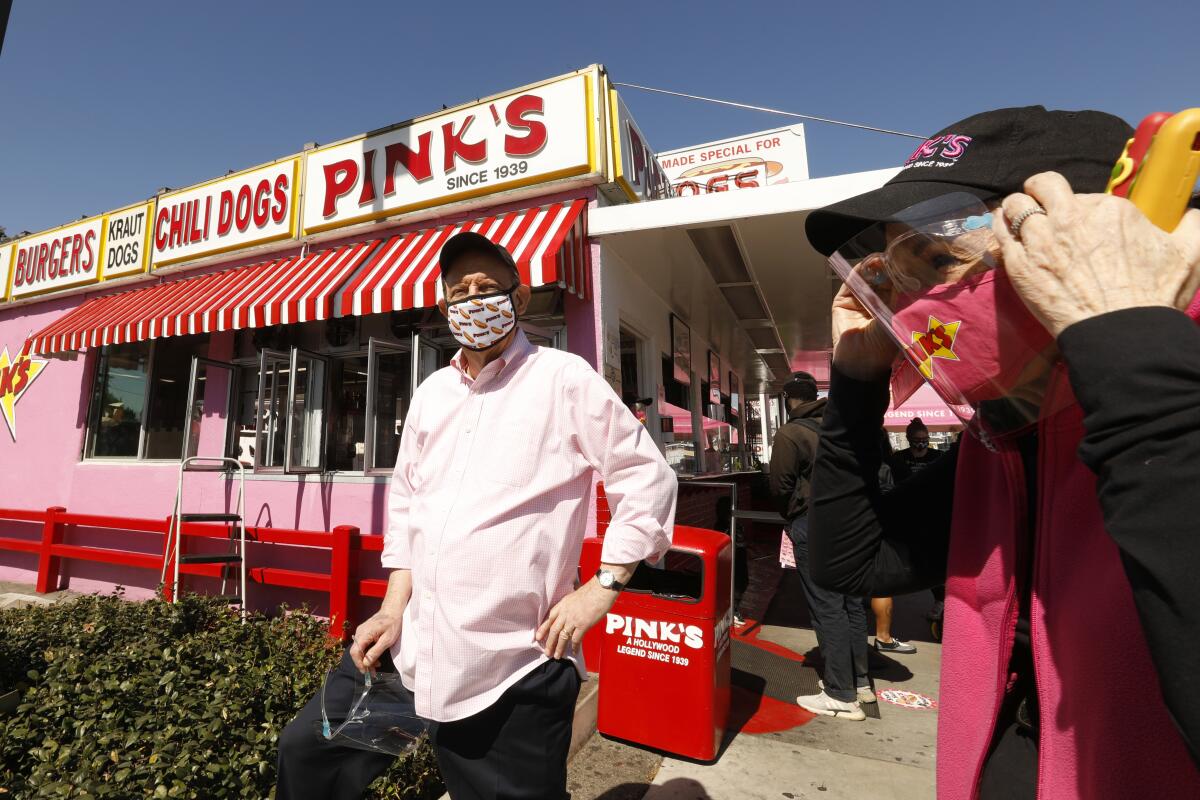
Curtain closed
Daniel Fish misses being in the room where it happens.
For theater stalwarts like the Tony Award-winning director, going from a three-dimensional stage to a virtual Zoom screen has been a challenge. “Theater happens in the moment,” he said. “What I’m interested in is people being alone and together in a room.”
Theater directors, performers and writers are struggling during the pandemic like many in the performing arts, but they‘re also showing impressive levels of tenacity and resilience, my colleague Charles McNulty reports.
Dael Orlandersmith, a New York-based playwright and performer, brought to a national TV audience her solo play about what happened after a police officer in Ferguson, Mo., shot Michael Brown. Culture Clash, a trio of political satirists, converted their theater performances into five-minute sketches made for screens.
Fish, whose staging of “Rodgers and Hammerstein’s Oklahoma!” won the Tony for best musical revival in 2019, is teetering on the edge of losing the health insurance he gets through the theater union. With his work cut down to almost nothing, Fish passed the time with meditative walks. Those sessions are now the inspiration for an upcoming film.
Something in the air
Pollution in Bergamo, Italy, is not new. The city northeast of Milan is surrounded by factories and highways. Many of the homes use wood-burning and pellet stoves.
The poor air quality is considered a leading cause of cancer in the area, and after the city became a deadly coronavirus hot spot last year, researchers are now investigating whether one longstanding health crisis played a role in making a new one worse.
Bergamo, New York and parts of China were among the first places to suffer large coronavirus outbreaks last spring. Researchers noticed how those places also suffered from high levels of air pollution. A study published in the December issue of the journal Cardiovascular Research found that exposure to tiny particles 2.5 micrometers or smaller correlated with a higher percentage of avoidable deaths from COVID-19 among those who came down with the disease.
In 2019, Bergamo averaged 18.5 micrograms of those particles per cubic meter of air. In Los Angeles, it was 12.7.
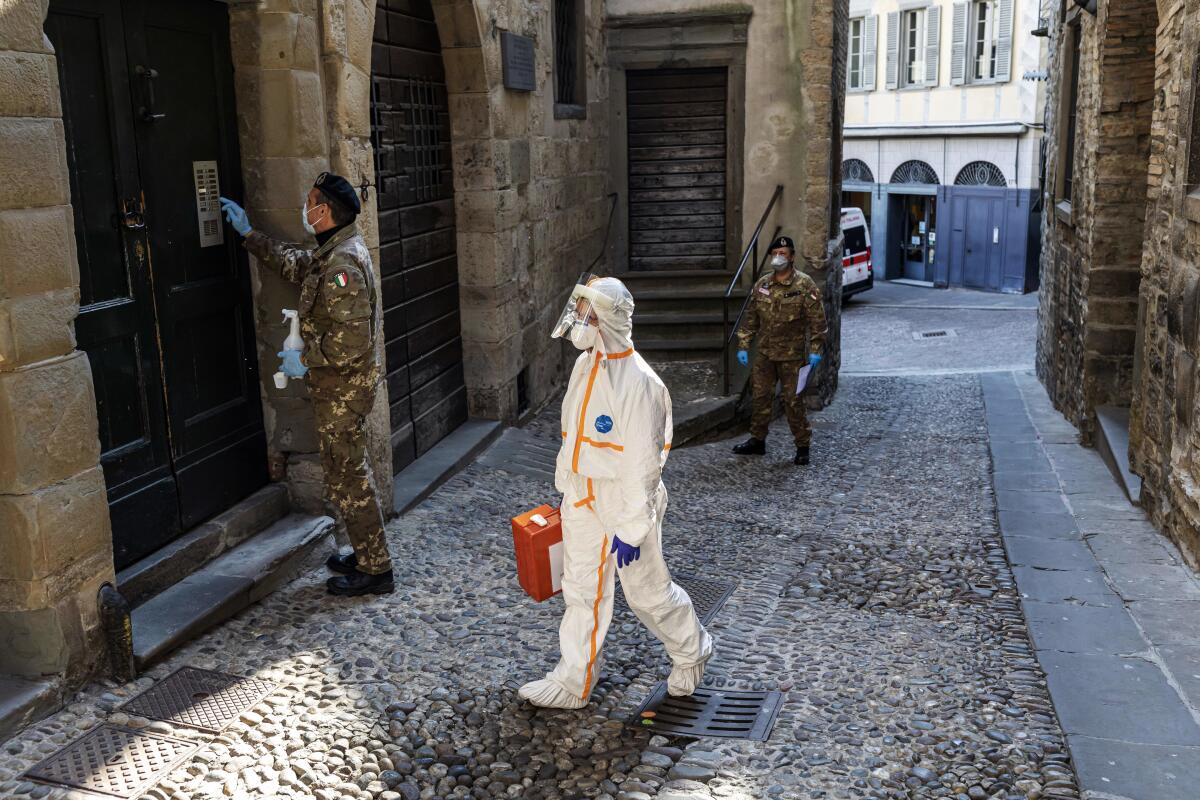
Your support helps us deliver the news that matters most.
What to do this weekend
Get outside. Rent a garden and make it your oasis amid the coronavirus chaos. Healing Gardens is an online marketplace where people can rent private, organic gardens the way they reserve homes on Airbnb. Guests can use the open space for yoga and meditation or simply enjoy the greenery. If you want to get further afield, you can start planning a pandemic-proof road trip. Subscribe to our Escapes newsletter for more travel ideas and The Wild for more on the outdoors.
Watch something great. Our weekend TV watch list includes a conversation between Oprah and Prince Harry and Meghan Markle on life after the royal family. And in his Indie Focus newsletter‘s roundup of new movies, Mark Olsen highlights “Raya and the Last Dragon,” the first Disney animated film inspired by Southeast Asian cultures.
Eat something great. Upgrade your basic salad with one of Ben Mims’ recipes that prove salad is better without lettuce. If you’re not in the mood to cook, try ordering delivery while exploring a new service aimed at helping restaurants avoid the huge fees associated with popular apps like GrubHub and DoorDash. For more, subscribe to our Cooking newsletter or our restaurants critics’ Tasting Notes newsletter.
Go online. Here’s The Times’ guide to the internet for when you’re looking for information on self care, feel like learning something new or interesting, or want to expand your entertainment horizons.
The pandemic in pictures
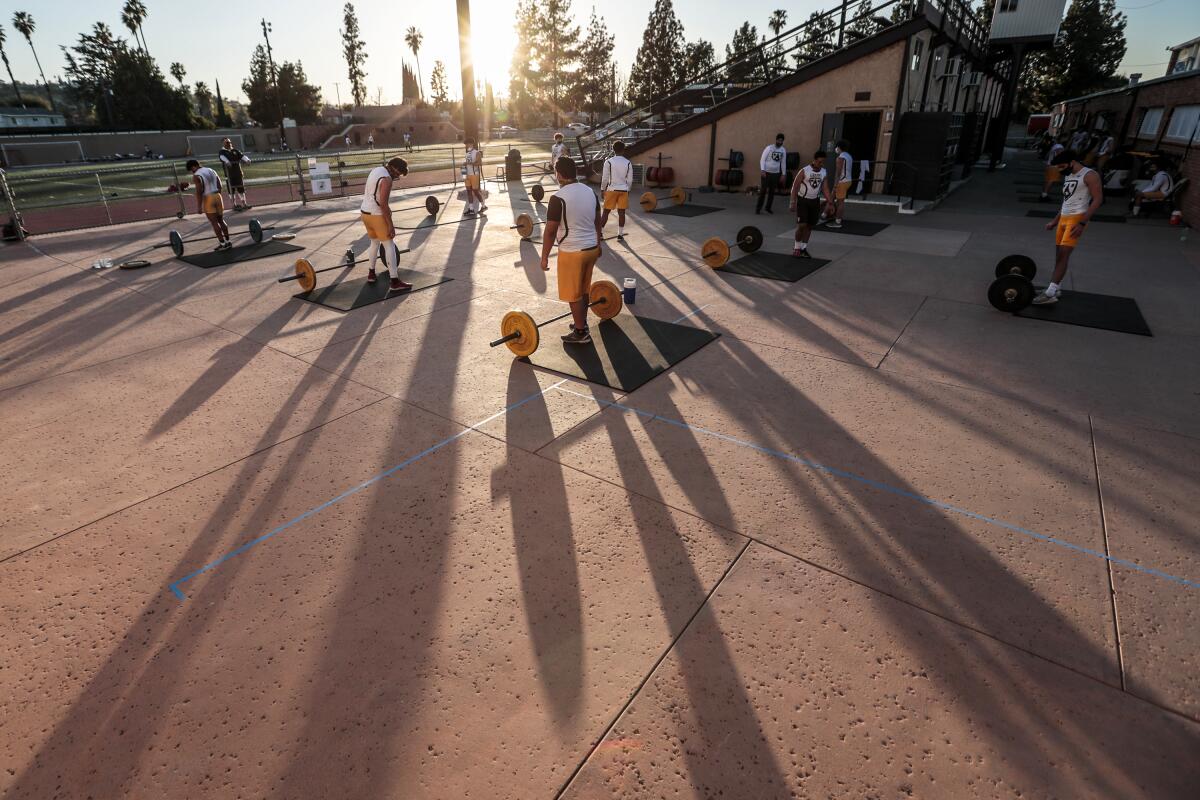
Crespi High football coach Dameon Porter turned to face the stands. Normally, the Encino high school’s bleachers would seat fans, parents and cheering students. Now his players looked back at him from the other side of the fence.
Practice looks much different for high school football teams preparing for their first games since 2019 now that high-contact outdoor youth sports were allowed to return last week. Coaches spray equipment with disinfectant and point thermometers at players’ foreheads before they enter the field. Players speak to teammates through masks. Everyone is supposed to be tested each week.
It’s not the environment they remember, but players and coaches were eager to return any way possible. “I saw happiness in [the players] and the excitement lining up for equipment,” said Santa Ana Mater Dei High coach Bruce Rollinson. It was what they had waited for.”

Resources
Need a vaccine? Keep in mind that supplies are limited, and getting one can be a challenge. Sign up for email updates, check your eligibility and, if you’re eligible, make an appointment where you live: City of Los Angeles | Los Angeles County | Kern County | Orange County | Riverside County | San Bernardino County | San Diego County | San Luis Obispo County | Santa Barbara County | Ventura County
Practice social distancing using these tips, and wear a mask or two.
Watch for symptoms such as fever, cough, shortness of breath, chills, shaking with chills, muscle pain, headache, sore throat and loss of taste or smell. Here’s what to look for and when.
Need to get tested? Here’s where you can in L.A. County and around California.
Americans are hurting in many ways. We have advice for helping kids cope, resources for people experiencing domestic abuse and a newsletter to help you make ends meet.
We’ve answered hundreds of readers’ questions. Explore them in our archive here.
For our most up-to-date coverage, visit our homepage and our Health section, get our breaking news alerts, and follow us on Twitter and Instagram.




